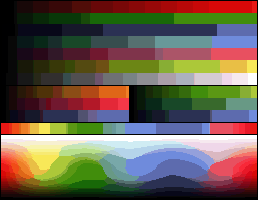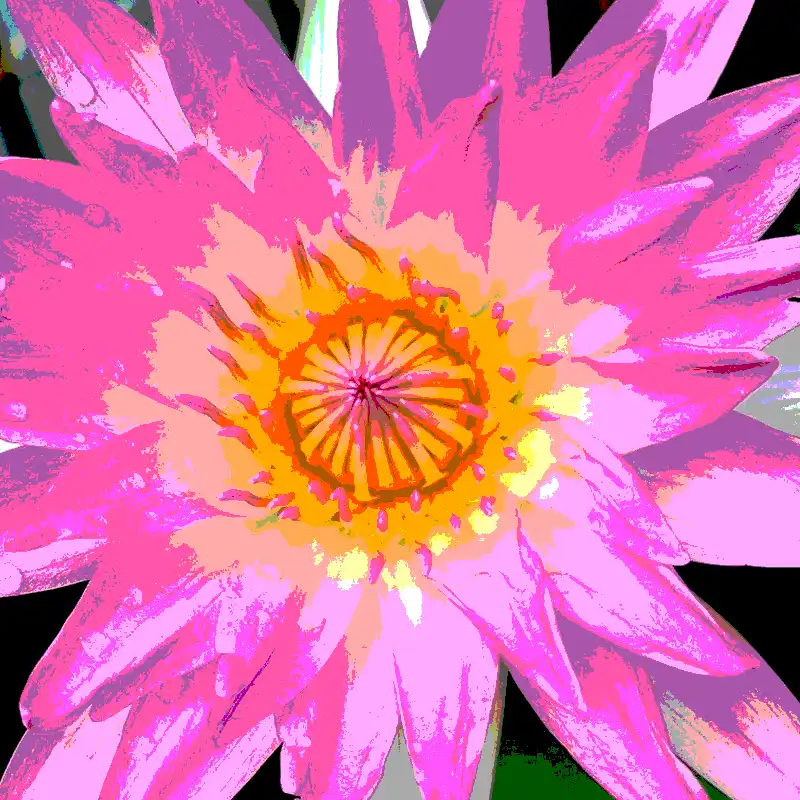Here it is!
I implemented three different palettes:
- Random palette (with random colors)
- Standard palette (RGB cube)
- Adaptive palette (with median cut algorithm)
You can click on the different buttons to switch the palette and press - or + to add/ remove colors from the palette.
/**
* Quantize colors interface
* Topic: https://discourse.processing.org/t/posterization-filter-explained
* Joseph HENRY
*/
import java.util.Arrays;
import java.util.Collections;
import java.util.Comparator;
import java.util.List;
/**
* Generic class for a palette
*/
abstract class Palette {
IntList colors;
Palette() {
colors = new IntList();
}
void addColor(color c) {
colors.append(c);
}
void addRandomColor() {
colors.append(color(random(255), random(255), random(255)));
}
color getClosestColorTo(color c) {
int minIndex = 0;
float minDistance = distanceBetweenColorsSq(c, colors.get(0));
for (int i = 1; i < colors.size(); i++) {
float distance = distanceBetweenColorsSq(c, colors.get(i));
if (distance < minDistance) {
minIndex = i;
minDistance = distance;
}
}
return colors.get(minIndex);
}
abstract String toString();
abstract void increase();
abstract void decrease();
void display(int x, int y, int w, int h) {
int xSquares = 1;
while (xSquares * ((h * xSquares) / (float) w) < colors.size()) {
xSquares++;
}
float s = (float) w / xSquares;
int ySquares = int(h / s);
stroke(0);
pushMatrix();
translate(x, y);
for (int i = 0; i < xSquares; i++) {
for (int j = 0; j < ySquares; j++) {
int loc = i + j * xSquares;
if (loc >= colors.size()) break;
fill(colors.get(loc));
square(i * s, j * s, s);
}
}
popMatrix();
}
}
/**
* Palette with random colors
*/
class RandomPalette extends Palette {
RandomPalette(int n) {
for (int i = 0; i < n; i++) {
addRandomColor();
}
}
void increase() {
addRandomColor();
}
void decrease() {
colors.pop();
}
String toString() {
return "Random palette (" + colors.size() + " colors)";
}
}
/**
* Standard palette with RGB cube
*/
class StandardPalette extends Palette {
int power;
StandardPalette(int power) {
this.power = power;
computeColors();
}
void increase() {
power++;
computeColors();
}
void decrease() {
power--;
if (power <= 0) power = 1;
computeColors();
}
/**
* Compute colors by dividing a 3D RGB cube
*/
void computeColors() {
colors.clear();
float offset = (float) 255 / power;
for (int x = 0; x <= power; x++) {
float r = x * offset;
for (int y = 0; y <= power; y++) {
float g = y * offset;
for (int z = 0; z <= power; z++) {
addColor(color(r, g, z * offset));
}
}
}
}
String toString() {
return str(power * 3) + " bit palette";
}
}
/**
* Used to sort a list of colors
*/
class ColorComparator implements Comparator<Integer> {
int shift;
ColorComparator(int shift) {
this.shift = shift;
}
int compare(Integer o1, Integer o2) {
float a = ((o1 >> shift) & 0xFF);
float b = ((o2 >> shift) & 0xFF);
if (a < b) return -1;
else if (a > b) return 1;
else return 0;
}
}
/**
* Palette where the colors are statistically choosen
*/
class AdaptivePalette extends Palette {
PImage fromImg;
int n;
AdaptivePalette(PImage img, int n) {
this.n = n;
this.fromImg = img.copy();
compute();
}
void increase() {
n *= 2;
compute();
}
void decrease() {
n /= 2;
if (n <= 1) n = 1;
compute();
}
/**
* Implementation of the median cut algorithm
* See: https://en.wikipedia.org/wiki/Median_cut
*/
void compute() {
colors.clear();
fromImg.loadPixels();
List<List<Integer>> buckets = new ArrayList();
// Put all the pixels into a bucket
buckets.add(new ArrayList());
for (int i = 0; i < fromImg.pixels.length; i++) buckets.get(0).add(fromImg.pixels[i]);
// Continue dividing buckets until we reach the color number target
while (buckets.size() != n) {
List<List<Integer>> newBuckets = new ArrayList();
for (List<Integer> bucket : buckets) {
// Compute the greatest range between RGB
float minR = 256;
float maxR = -1;
float minG = 256;
float maxG = -1;
float minB = 256;
float maxB = -1;
for (int i = 0; i < bucket.size(); i++) {
color c = bucket.get(i);
float r = (c >> 16) & 0xFF;
float g = (c >> 8) & 0xFF;
float b = (c & 0xFF);
if (r < minR) minR = r;
if (r > maxR) maxR = r;
if (g < minG) minG = g;
if (g > maxG) maxG = g;
if (b < minB) minB = b;
if (b > maxB) maxB = b;
}
float rangeR = maxR - minR;
float rangeG = maxG - minG;
float rangeB = maxB - minB;
// Store the shift so we can compare the colors later
int shift = 0;
if (rangeR > rangeG && rangeR > rangeB) {
shift = 16;
} else if (rangeG > rangeR && rangeG > rangeB) {
shift = 8;
}
// Sort the bucket
Collections.sort(bucket, new ColorComparator(shift));
// Cut the bucket in half
int middle = bucket.size() / 2;
newBuckets.add(bucket.subList(0, middle));
newBuckets.add(bucket.subList(middle, bucket.size()));
}
// Replace by the new buckets
buckets = newBuckets;
}
// Compute the average colors for each bucket
for (List<Integer> bucket : buckets) {
float rSum = 0;
float gSum = 0;
float bSum = 0;
for (Integer c : bucket) {
rSum += (c >> 16) & 0xFF;
gSum += (c >> 8) & 0xFF;
bSum += c & 0xFF;
}
colors.append(color(
(float) rSum / bucket.size(),
(float) gSum / bucket.size(),
(float) bSum / bucket.size()));
}
}
String toString() {
return "Adaptive palette (" + n + " colors)";
}
}
/**
* Display an image with squares (to remove filtering)
*/
void displayImage(PImage img, String legend, int xPos, int yPos, int scale) {
noStroke();
pushMatrix();
translate(xPos, yPos);
// Display squares
for (int x = 0; x < img.width; x++) {
for (int y = 0; y < img.height; y++) {
fill(img.pixels[x + y * img.width]);
square(x * scale, y * scale, scale);
}
}
// Display legend
textAlign(CENTER, CENTER);
fill(255);
textSize(30);
text(legend, (img.width * scale) / 2.0, (img.height * scale) - 50);
popMatrix();
}
/**
* Computes the distance squared between two colors
*/
float distanceBetweenColorsSq(color c1, color c2) {
float r2 = (c2 >> 16) & 0xFF;
float g2 = (c2 >> 8) & 0xFF;
float b2 = (c2 & 0xFF);
float r1 = (c1 >> 16) & 0xFF;
float g1 = (c1 >> 8) & 0xFF;
float b1 = (c1 & 0xFF);
return (r2 - r1) * (r2 - r1) +
(g2 - g1) * (g2 - g1) +
(b2 - b1) * (b2 - b1);
}
/**
* Color quantize an image with the given palette
*/
PImage quantizeWithPalette(PImage img, Palette palette) {
PImage copy = img.copy();
img.loadPixels();
copy.loadPixels();
for (int x = 0; x < copy.width; x++) {
for (int y = 0; y < copy.height; y++) {
int loc = x + y * copy.width;
copy.pixels[loc] = palette.getClosestColorTo(img.pixels[loc]);
}
}
return copy;
}
/**
* Clickable button class
*/
class Button {
String label;
int x, y;
float w, h;
color bgColor;
int fontSize = 20;
Button(String label, int x, int y, color bgColor) {
this.label = label;
this.x = x;
this.y = y;
this.bgColor = bgColor;
this.w = textWidth(label) + 10;
this.h = fontSize * 1.5;
}
boolean isMouseHover() {
return mouseX > x - w / 2 &&
mouseX < x + w / 2 &&
mouseY > y - h / 2 &&
mouseY < y + h / 2;
}
void display() {
display(false);
}
void display(boolean active) {
pushStyle();
textSize(fontSize);
rectMode(CENTER);
if (isMouseHover()) {
stroke(255);
} else {
noStroke();
}
if (active) fill(#40805b);
else fill(bgColor);
rect(x, y, textWidth(label) + 10, fontSize * 1.7, 5);
textAlign(CENTER, CENTER);
fill(255);
text(label, x, y - 5);
popStyle();
}
}
PImage img, quantized;
int currentPaletteIndex = 0;
List<Palette> palettes;
List<Button> buttons;
Button decrease, increase;
Palette currentPalette() {
return palettes.get(currentPaletteIndex);
}
void quantizeImage() {
quantized = quantizeWithPalette(img, currentPalette());
}
void setup() {
size(1200, 700);
img = loadImage("https://upload.wikimedia.org/wikipedia/commons/d/d7/RGB_24bits_palette_sample_image.jpg");
palettes = new ArrayList<Palette>() {
{
add(new StandardPalette(1));
add(new RandomPalette(8));
add(new AdaptivePalette(img, 8));
}
};
quantizeImage();
// Buttons
final int buttonYPos = height - 50;
buttons = new ArrayList<Button>() {
{
add(new Button("Standard palette", 100, buttonYPos, color(100)));
add(new Button("Random palette", 300, buttonYPos, color(100)));
add(new Button("Adaptive palette", 500, buttonYPos, color(100)));
}
};
decrease = new Button("-", 650, buttonYPos, color(#574fc3));
increase = new Button("+", 700, buttonYPos, color(#fe3548));
}
void draw() {
background(50);
displayImage(img, "24 bit palette", 0, 0, 3);
displayImage(quantized, currentPalette().toString(), 450, 0, 3);
currentPalette().display(900, 0, 300, 600);
for (int i = 0; i < buttons.size(); i++) {
buttons.get(i).display(i == currentPaletteIndex);
}
decrease.display();
increase.display();
}
void mousePressed() {
for (int i = 0; i < buttons.size(); i++) {
Button button = buttons.get(i);
if (button.isMouseHover()) {
currentPaletteIndex = i;
quantizeImage();
break;
}
}
if (decrease.isMouseHover()) {
currentPalette().decrease();
quantizeImage();
}
if (increase.isMouseHover()) {
currentPalette().increase();
quantizeImage();
}
}
void keyPressed() {
if (keyCode == RIGHT) {
currentPalette().increase();
quantizeImage();
} else if (keyCode == LEFT) {
currentPalette().decrease();
quantizeImage();
}
}






